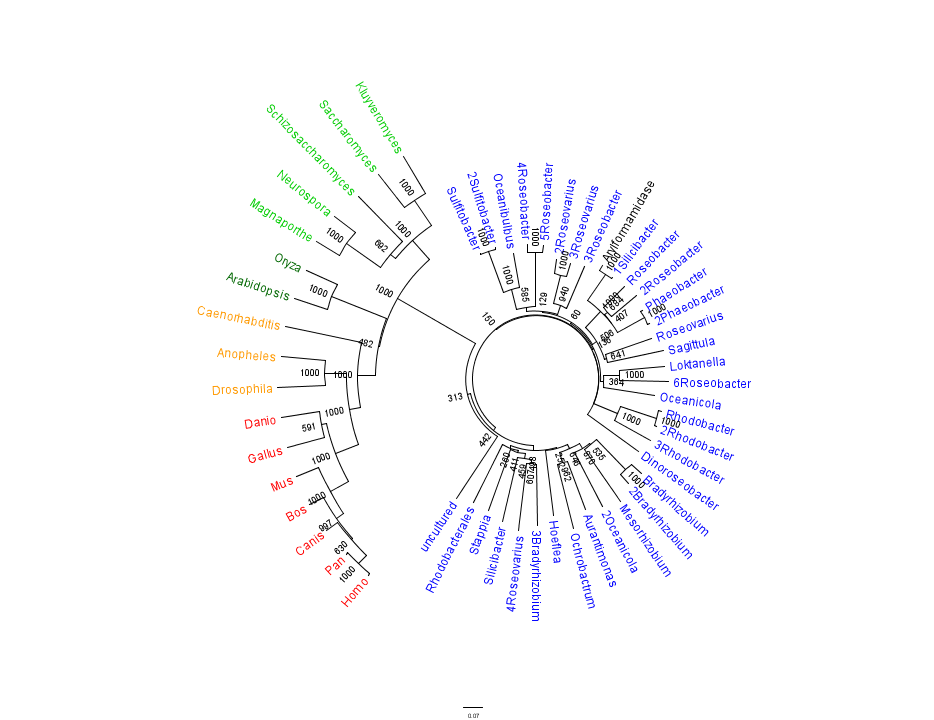Arylformamidase Sequence & Homology: Difference between revisions
No edit summary |
No edit summary |
||
| Line 4: | Line 4: | ||
Using the query sequence Target 13, pdb:2pbl "Arylformamidase", a BLAST search was performed on the bacterial sequence [[Arylformamidase.txt]] using a non-redundant database. The top scoring matches to an E-value of 3e-054, 35 sequences in total, were selected. Eukaryotic homologous sequences sequences were found using HOMOLOGENE. These were appended to the list and a multple sequece alignment was performed using CLUSTAL X. | Using the query sequence Target 13, pdb:2pbl "Arylformamidase", a BLAST search was performed on the bacterial sequence [[Image:Arylformamidase.txt]] using a non-redundant database. The top scoring matches to an E-value of 3e-054, 35 sequences in total, were selected. Eukaryotic homologous sequences sequences were found using HOMOLOGENE. These were appended to the list and a multple sequece alignment was performed using CLUSTAL X. | ||
A similar BLAST search was performed using the human homologue to our query sequence. The top scoring matches were very similar to those found in the BLAST search using the original sequence. | A similar BLAST search was performed using the human homologue to our query sequence. The top scoring matches were very similar to those found in the BLAST search using the original sequence. | ||
Revision as of 06:04, 29 May 2008
Our query sequence "Arylformamidase" is a putatuve thioesterase isloated from a Silicibacter sp. The sequence is 262 residues in length.
1. Method
Using the query sequence Target 13, pdb:2pbl "Arylformamidase", a BLAST search was performed on the bacterial sequence File:Arylformamidase.txt using a non-redundant database. The top scoring matches to an E-value of 3e-054, 35 sequences in total, were selected. Eukaryotic homologous sequences sequences were found using HOMOLOGENE. These were appended to the list and a multple sequece alignment was performed using CLUSTAL X.
A similar BLAST search was performed using the human homologue to our query sequence. The top scoring matches were very similar to those found in the BLAST search using the original sequence.
The data output from the multiple sequence alignment was bootstrapped 1000 times and a phylogenetic tree was created using the neighbour-joining algorythm. The program FigTree was used to create the visual representation of this tree(Figure 1).
Figure 1.
Unrooted phylogenetic tree of highest scoring results from a BLAST search of bacterial sequnces using a non-redundant database and homologous eukaryotic sequences sourced from HOMOLOGENE.
2. Results
Figure 1 shows that the query sequence "Arylformamidase" grouped with bacterial sequences, shown cloured in Red and Purple. The bootstrap values reveal low confidence with many of the nodes occurring lower down on the phylogenetic tree revealing a possible explanation for certain closely related species to be grouped into separate clades. However, despite low bootstrap scores, the grouping does reliably separate prokaryotes from eukaryotes and the eukaryotes themsselves are clearly distinguished between yeasts and moulds (shown in Blue), plants (Green), invertebrates (Orange) and vertebrates (shown in Black).
The alignment revealed several conserved regions accross all species, thereby indicating a high level of conservation from Bacteria through Eukaryota. These included vertebrates, invertebrates, plants and single-celled eukaryotes (Figure 2).
Return to Arylformamidase
